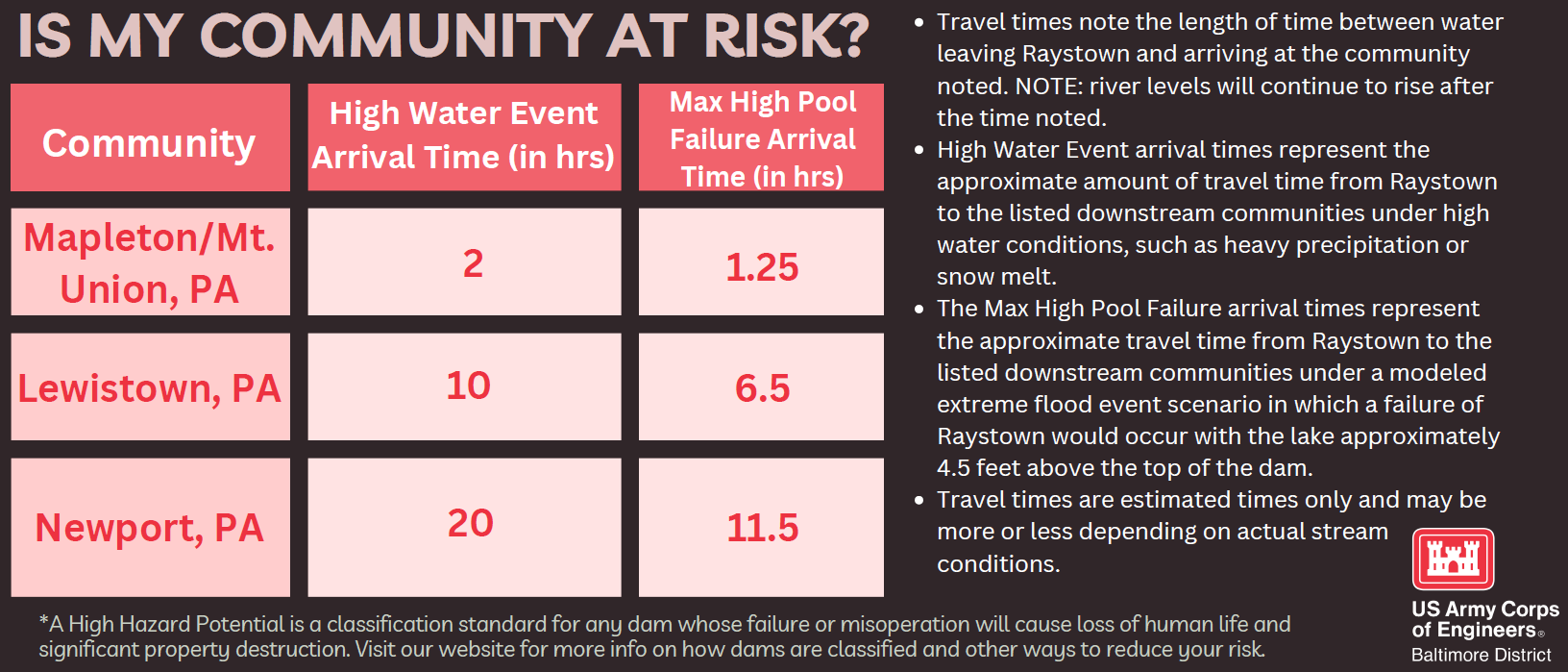RAYSTOWN LAKE, Pa. -- The U.S. Army Corps of Engineers, Baltimore District, is holding a field training exercise at Raystown Lake in coordination with local, state and federal agencies to prepare for potential high-water emergencies, June 26-30, 2023. The training exercise is designed to present realistic problems in a simulated environment to identify any gaps in policies and plans that could hinder actual emergency situations.
A multidisciplinary team of USACE subject matter experts, as well representatives from Federal Emergency Management Agency; Pennsylvania Emergency Management Agency; Cumberland, Huntingdon, Bedford, Mifflin and Perry Counties; Smithfield Township; and Alleghany Electric; will undergo a hypothetical scenario caused by a stalled tropical storm that has inundated the local region, triggering a Presidential disaster declaration and dam distress.
“Exercises like the one we are doing here at Raystown Dam facilities with our partner agencies help us build resilience in our systems and identify resource gaps, so that we can address them before a real event occurs,” said Dorie Murphy, Baltimore District emergency management chief. “This helps us validate our plans and learn how to best communicate with and protect the people who would be impacted most.”
The exercise is conducted in conjunction with the release of the Raystown Lake Dam Risk Communication Plan, a comprehensive guide for risk communication efforts pertaining to Raystown Dam. The plan serves as a roadmap for how USACE personnel and its partners communicate risks associated with flooding that results from a high-volume release of water from the dam’s spillway or potential breach during significant storm events.
Know the risks of living near Raystown Lake
Although Raystown Dam reduces the risk of flooding to downstream communities, it does not eliminate the risk of flooding. The most likely scenario that could result in downstream flooding from the dam would be a high-volume release of water from the dam’s spillways during significant storm events. To maintain the structural integrity of the dam when the water level in the reservoir gets high, the spillways release water to the Raystown Branch Juniata River. The frequency and amount of water being released could be great enough to cause flooding in downstream communities. Such higher releases from the spillways could create conditions similar to how the river might behave if the dam did not exist.
There are also unlikely, but far more devastating, scenarios involving breach of the dam that would produce significant flooding. This could involve situations such as a rare, extreme rainfall event resulting in water flowing over the earthen dam, eroding the dam and leading to a breach of the dam. If a breach were to occur, an uncontrolled surge of water would flow out of the reservoir, flooding downstream communities. In the event of a flood, Huntingdon, Mapleton, Mt. Union, Lewistown, Shirleysburg, and adjacent communities are in the most immediate danger. Other communities along the Juniata River would also be impacted.

In the scenarios described above, the downstream floodwater would be swift and deep resulting in potential loss of life, overflowing levees and destruction to key infrastructure. In the less likely dam breach scenarios, the water depth, property damage, and lives lost could be far greater.
Prepare your home and family
Flood risk management is a shared responsibility. From federal, state, and local government to the individual level, we all have a role to play to reduce flood risk. Here are some ways you can proactively reduce risk:
- Inform your family of dam failure flood risks, and make sure each family member knows what to do in the event of an emergency
- Seal basement walls with waterproofing compounds to avoid seepage
- Keep valued possessions and important papers on an upper level of your home or in a safety deposit box
- Prepare an emergency kit
- Know your evacuation routes
If a flood is likely in your area, you should:
- Listen to the radio or television for information
- Be aware that dam failure or operational flooding can occur
- Move to higher ground immediately and do not wait for instructions to move
- Get to high ground if flooding is imminent
If you must leave your home, remember these evacuation tips:
- Do not walk-through moving water as only six inches of moving water can make you fall
- If you have to walk in water, walk where water is not moving and use a stick to check the firmness of the ground in front of you
- Do not drive into flooded areas
- If floodwaters rise around your car, abandon the car and move to higher ground if you can do so safely as you and the vehicle could be quickly swept away
About Raystown Lake
Raystown Lake is the largest lake located entirely in Pennsylvania and offers 8,300 surface acres of clear water surrounded by 21,000 acres of forested mountain slopes. Raystown is a multi-purpose lake constructed and managed by USACE for flood damage reduction, recreation and natural resource opportunities, and hydropower.
For more information about the Raystown Lake Dam Risk Communication Plan, please visit https://www.nab.usace.army.mil/missions/dams-recreation/raystown-lake/raystown-lake-dam-risk-communication/.